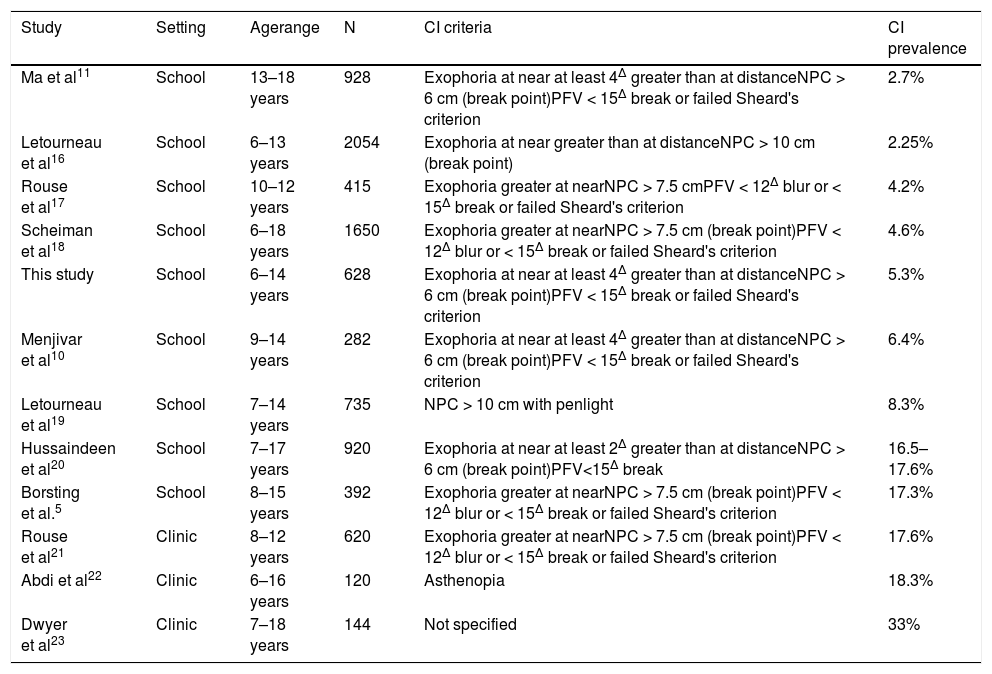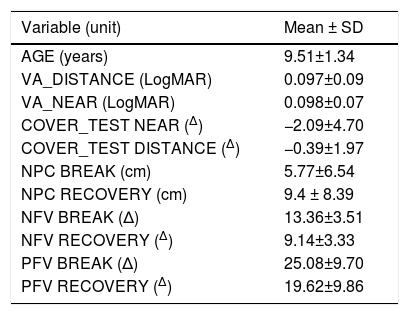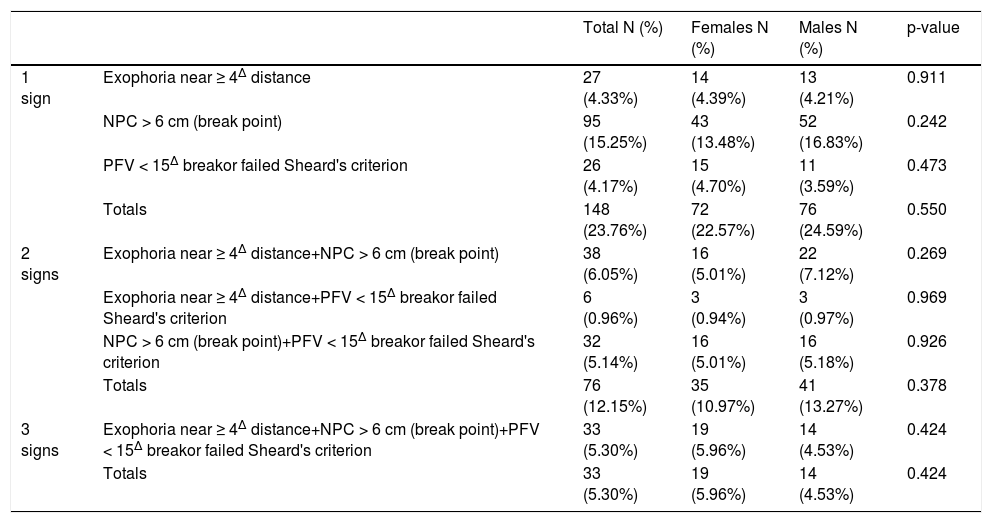Convergence insufficiency (CI) at an early age can lead to learning difficulties affecting school performance. The aim of this study was to examine the prevalence of CI in a non-clinical population of Spanish children using well defined clinical criteria and to determine whether sex is a risk factor.
MethodsVisual acuity and binocular vision tests were performed in 628 children aged 6–14 years (mean age 9.6 ± 1.3 years) at three schools in the Madrid Community, Spain. To assess CI prevalence we used CITT (Convergence Insufficiency Treatment Trial) criteria. The three signs considered were: i) exophoria at least 4∆ greater at near than at far; ii) near break point of convergence (NPC) ≥ 6 cm; and iii) reduced positive fusional vergence (PFV) at near (≤ 15∆ base-out break or failed Sheard's criterion).
ResultsThe CI prevalence detected was 5.30% (33 children). Proportions of children with one or two signs of CI were 23.76% (148 children) and 12.20% (76 children), respectively. No differences in these CI rates by sex were detected.
ConclusionThe clinically significant CI prevalence observed here suggests the need for more binocular vision screening programmes in school settings.
Visual dysfunction in school age children can lead to learning difficulties both at school and at home as it may negatively affect attention and reading skills. In effect, learning deficiency at school has been related to various aspects of visual function including binocular vision status1–3
Convergence insufficiency (CI) is a sensorimotor anomaly that affects the binocular vision system resulting in an inability to adequately converge or sustain convergence during near visual tasks.4 In both adults and children, CI is frequently associated with asthenopic symptoms like headache, transient blurred vision, diplopia, eyestrain or difficulty in concentrating while conducting near work.1,2,5–7 Rouse et al.2,3 reported that parents of children with symptomatic CI described their poor academic performance in terms of near distance work compared with parents of children with normal binocular vision.
According to Blum et al.,8 the goal of vision screening is to identify children with a visual problem or an eye condition so that they can be referred to a qualified professional for a complete evaluation. The early detection of CI is beneficial as this problem responds well and quickly to vision therapy.9 However, school screening programmes often focus on the detection of reduced visual acuity rather than binocular vision problems such as convergence insufficiency. In addition, the best test to screen for the presence of convergence insufficiency is not known.10
Three clinical signs were defined in the Convergence Insufficiency Treatment Trial (CITT): exophoria at least 4∆ greater at near than at far, near break point of convergence (NPC) ≥ 6 cm and reduced positive fusional vergence (PFV) at near (failed Sheard's criterion or ≤15∆ base-out break). According to Ma et al., CI can be described as definite when all 3 signs are present, highly suspicious when there are 2 or 3 signs and unlikely when there is only 1 sign.11 In Table 1, reported CI prevalence data are provided, indicating wide variation from 2.25% to 33%.12 This variation could be attributed to inconsistency and variability in the diagnostic criteria used. Binocular vision dysfunction prevalence studies have analysed Spanish University students,13–15 but we lack updated data on CI prevalence for school-aged children in our country.
Summary of published convergence insufficiency (CI) prevalence studies including criteria used to define CI Sheard's criterion = positive fusional vergence break point less than twice the phoria; NPC = near point of convergence; PFV= near point of positive fusional vergence; cm = centimetre; Δ = prism diopter (Source: adapted from different reports).
| Study | Setting | Agerange | N | CI criteria | CI prevalence |
|---|---|---|---|---|---|
| Ma et al11 | School | 13–18 years | 928 | Exophoria at near at least 4∆ greater than at distanceNPC > 6 cm (break point)PFV < 15∆ break or failed Sheard's criterion | 2.7% |
| Letourneau et al16 | School | 6–13 years | 2054 | Exophoria at near greater than at distanceNPC > 10 cm (break point) | 2.25% |
| Rouse et al17 | School | 10–12 years | 415 | Exophoria greater at nearNPC > 7.5 cmPFV < 12∆ blur or < 15∆ break or failed Sheard's criterion | 4.2% |
| Scheiman et al18 | School | 6–18 years | 1650 | Exophoria greater at nearNPC > 7.5 cm (break point)PFV < 12∆ blur or < 15∆ break or failed Sheard's criterion | 4.6% |
| This study | School | 6–14 years | 628 | Exophoria at near at least 4∆ greater than at distanceNPC > 6 cm (break point)PFV < 15∆ break or failed Sheard's criterion | 5.3% |
| Menjivar et al10 | School | 9–14 years | 282 | Exophoria at near at least 4∆ greater than at distanceNPC > 6 cm (break point)PFV < 15∆ break or failed Sheard's criterion | 6.4% |
| Letourneau et al19 | School | 7–14 years | 735 | NPC > 10 cm with penlight | 8.3% |
| Hussaindeen et al20 | School | 7–17 years | 920 | Exophoria at near at least 2∆ greater than at distanceNPC > 6 cm (break point)PFV<15∆ break | 16.5–17.6% |
| Borsting et al.5 | School | 8–15 years | 392 | Exophoria greater at nearNPC > 7.5 cm (break point)PFV < 12∆ blur or < 15∆ break or failed Sheard's criterion | 17.3% |
| Rouse et al21 | Clinic | 8–12 years | 620 | Exophoria greater at nearNPC > 7.5 cm (break point)PFV < 12∆ blur or < 15∆ break or failed Sheard's criterion | 17.6% |
| Abdi et al22 | Clinic | 6–16 years | 120 | Asthenopia | 18.3% |
| Dwyer et al23 | Clinic | 7–18 years | 144 | Not specified | 33% |
The aim of the present study was to estimate using well-defined clinical criteria CI prevalence in healthy Spanish children, and to determine whether sex is a risk factor. Correlations between the different signs were also examined.
MethodsEthical approvalThe study protocol adhered to the ethical principles of the Declaration of Helsinki and good clinical practice, and was approved by the Research Ethics Committee of the CEU San Pablo University. Once the different schools had approved and agreed to participate in our study, written informed consent was obtained from parents.
In the Madrid Community, 713,245 children of the target age were registered in the school year 2018/2019.24 Based on finite sample prevalence data, the sample size required (p = 0.5; q = 0.5) for a 95% confidence interval was calculated at 384 children.
The study design was prospective, cross-sectional and multicentric. Of 680 children invited to participate, 640 children providing informed consent aged 6–14 years from three schools in Madrid were enrolled. Inclusion criteria were: age 6–14 years and near and distance visual acuity with or without correction of at least 0.1 (logMAR). Subjects were excluded if they had constant strabismus or any ocular or systemic disease that could interfere with visual function. Children were also excluded if they had an uncorrected refractive error of more than 0.50 D of myopia, 1.50 D of hyperopia and/or 1.50 D of astigmatism. The examination was carried out by 6 optometrists with more than 10 years of experience with vision anomalies. These examiners from a research group working at the San Pablo CEU University were trained to use the same protocol. The main author was responsible for analysing the data. For each participant, a clinical report was prepared according to the test results in which it was indicated if they needed a comprehensive eye examination. For a diagnosis of CI, the three CITT clinical signs described above had to be fulfilled.
Clinical measuresAt each school, tests were performed in a large quiet well-lit room (120 cd/m2, Tek Lumacolor II). Children who wore glasses were tested while wearing their correction.
The visual skills assessed were monocular and binocular visual acuity at far (6 m) and near (40 cm). Binocular vision measures were the near and distance cover test, near point of convergence (NPC), positive fusional vergence (PFV), and negative fusional vergence (NFV).
Visual acuity (VA) was first assessed monocularly and binocularly both at far and near distance using a logMAR Early Treatment Diabetic Retinopathy Study (ETDRS) chart and a standard equivalent Snellen near card. A translucent paddle was used for the cover test. The testing order was right eye, left eye and then both.
Distance and near horizontal phorias were measured using a prism bar in the cover test, cover-uncover and alternate cover test with a far and near 20/30 target.
Near point of convergence was assessed by the standard push-up technique using a single column of letters of 6/9 (20/30) equivalent at 40 cm on a near point rule. In this test, the subject is asked to follow an approaching target until the point where it appears double, or the examiner notes that one eye drifts outwards. Three measurements were made separated by at least 10 s of rest. Break and recovery point values were recorded as the average of the three measurements.25,26
Positive and negative fusional vergence ranges were measured at near distance. Negative (base-in) ranges were measured before positive (base-out) ranges to avoid vergence adaptation. Rosenfield et al.27 using a horizontal prism bar and a fixation target containing a single column of letters (20/30) increased the prism magnitude by about 2∆ per second, stopping at each prism jump and the child indicated “one clear image”. If the child reports blurry letters, after recording the blur point, the break point is identified by indicating “two or doubled” and the value noted. After reporting diplopia, the base prism is increased by 5∆, the prism amount should be decreased by 2 prisms per second, and the recovery point recorded when the child observes a single image. In this study, we considered a PFV break point lower than 15∆ as a sign of CI.
Statistical analysisStatistical analysis was performed using IBM SPSS version 24.0 software. The Kolmogorov–Smirnov test with Lilliefors correction was used to confirm the normal distribution of the collected data. Data were expressed as means (SD) for continuous variables and number and percentage for categorical variables and analyzed using the Chi-squared test and Fisher's exact test. For continuous variables we used either a 2-tailed t-test when normality and homogeneity of variance assumptions were met, or the nonparametric Mann–Whitney U test. Associations between the quantitative variables of interest were measured through Pearson's correlation coefficients. For all statistical tests, significance for a confidence interval of 95% was set at p < 0.05.
ResultsOf 640 participants enrolled, 5 were excluded because they had constant strabismus and 7 because they did not meet our established VA requirements. This left a study population of 628 children: 309 male and 319 female, aged 6–14 years (mean 9.6 ± 1.34 years). At the time of the tests, participants were in grades 1 to 8. Mean visual acuity for the population (Table 2) was 0.097 ± 0.009 LogMAR at far and 0.098 ± 0.007 LogMAR at near. A large percentage of the children (91.6%) had a visual acuity of 0.1 at both distances with their usual correction. Of 110 children who wore glasses (17.5%), 70 (63.63%) were female and 40 (36.36%) were male.
Means and standard deviations of the variables used to diagnose convergence insufficiency recorded in our study population Minus sign indicates exophoria. SD= standard deviation; ∆ = prism diopter; cm=centimetre.
Table 3 describes the number of study participants with CI. Of the 628 subjects examined, 371 showed no signs of CI, 148 (23.76%) showed one sign, 76 (12.15%) two signs and 33 (5.30%) three signs. Hence, 33 children had convergence insufficiency representing a prevalence of 5.30% in our study population. There were no significant (p>0.05) differences between the genders.
Number of signs of convergence insufficiency recorded in the children by sex.
Thirty-eight of the children (6.05%) had at least 4∆ more of exophoria at near than at far in addition to a distant NPC break point. Moderate negative correlation (p<0.05, r = −0.374) was observed between these two signs such that the greater the exophoria, the further away was the NPC.
Six children (0.96%) showed an exophoria that was 4∆ greater at near than at far along with a reduced PFV break point. These two signs displayed moderate positive correlation (p<0.05, r = 0.347) meaning that the greater the exophoria, the lower the PFV break point.
Thirty two children (5.14%) showed both reduced NPC and PFV break points. These two signs were moderately and positively correlated (p<0.05, r = 0.426) meaning that the further away the NPC break point, the lower the PFV break point.
Finally, 33 children (5.30%) showed the three characteristics signs of CI indicating a definite diagnosis.
DiscussionThis study provides CI prevalence data for a non-clinical population of Spanish children aged 6 to 14 years. Rates varied between 5.30% for a definite diagnosis to 23.76% for only one CI sign present. Two or three CI signs indicating a high suspicion of CI were detected in 12.15% of our study population.
These prevalences are similar to those reported by other authors in children of this age range.10,17,18 According to the CITT group criteria used to diagnose CI, a subject must have three characteristic signs. Our prevalence of three CI signs was slightly higher than that obtained in school screenings by the groups of Rouse17 (4.2%) and Scheiman18 (4.6%). It is important to consider the setting of a study, as results are not the same when assessment takes place in a school or clinic. In some studies, CI prevalences determined in an optometry office have been as high as 17%, as described by Rouse et al.21 and examinations in schools have provided a prevalence as low as 6%, as detected by Menjivar et al.10 (Table 1) The key to screening success is to detect patients with a binocular visual disorder early on. Nevertheless, some CI prevalence studies have yielded higher rates than observed here. This could be due to this bias of measurements taken in the clinic. In contrast, the children enrolled in this study were examined at school and had no ocular discomfort or apparent symptoms.
No differences in CI prevalence by sex were detected here. This finding is inconsistent with the results of other studies. Ma et al.11 reported a 3:2 ratio of girls to boys with CI but in a population comprising 230 more female than male participants. In other studies conducted in populations with similar numbers of boys and girls, as in the present study, similar CI prevalences were observed in males and females.17,20,21,28,29
Most of the children diagnosed with CI in our study had a visual acuity of 0.1 LogMAR. Children with CI usually show adequate visual acuity as this problem affects vision and not sight. For this reason, it is important to emphasize that CI is a binocular anomaly. Our findings point to a need for more exhaustive examinations in school-aged children, as visual acuity does not offer any information about other deficient visual skills that could help explain learning or attention problems.2,3,30,31 Moreover, CI can have an impact on quality of life, especially during reading and near work.
ConclusionVision screening is today an integral part of the education system in many countries.32 However, this screening, based on 3 gold-standard tests, focuses on near and far distance single eye skills and lacks a specific test to assess binocular visual skills. As binocular visual skills are essential for children's school performance, the early detection and treatment of CI could significantly improve their learning ability.
The prevalence of CI in this non-clinical pediatric population of the Madrid region (Spain) aged 6 – 14 years is similar to reported figures for other developed countries. School screening is important to detect this insufficiency and other non-strabismic or strabismic binocular vision anomalies. As an overall conclusion, vision screening including binocular vision tests in a school setting is strongly recommended.











